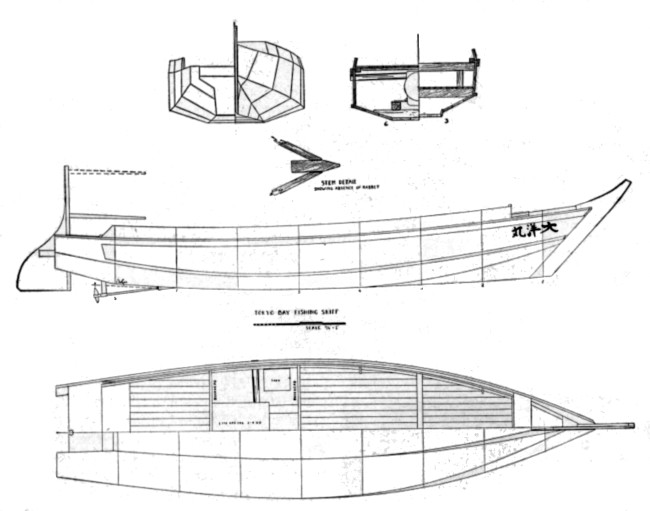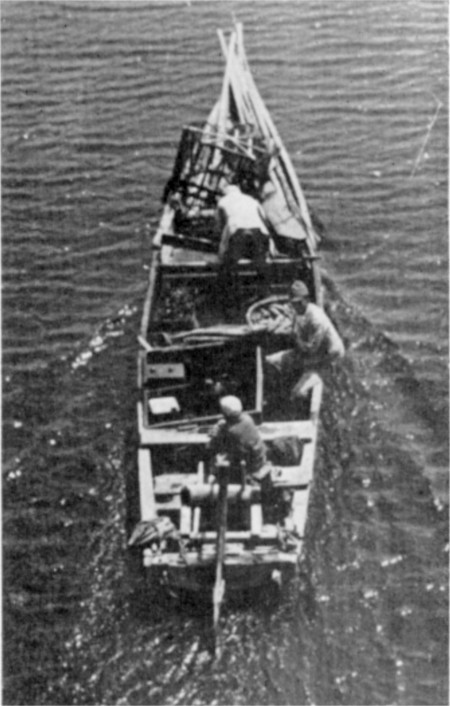Tokyo Bay Fishing Skiff
By Philip C. Bolger, photo by Walter J. Czajka
Adapted from "The Rudder", March 1948. This is perhaps the earliest published article by Phil Bolger who later wrote many books on boat design, and contributed many articles to the Small Boat Journal, WoodenBoat and Messing about in boats.
This particular design was slightly modified and republished in "Messing about in boats" Vol. 11, No. 11 (15 October 1993) as a "Yamato Fishing Launch", Design #511, 7.6m x 1.84m (25'0" x 6'0"), "from notes ... Tokyo, 1947" by the author as "PCP" and the photogapher as "WJC".
Walt and I took a walk in Tokyo one day last spring looking for boats, he to take pictures and I to make notes and talk – especially talk. I discussed with him what I am about to relate and he seemed to think it interesting. I hope it is.
An officer of our unit gave us a lift as far as the palace, and we walked down past the Seventh Cavalry area to the harbor. We found whalers and fishermen, lighters and barges, naval craft and a couple of big squareriggers. We became very hot while walking, since it was a warm day in April and winter uniform still prescribed.
The boats that took my fancy were a type of light power craft running twenty to forty feet overall which for want of a better name I call Tokyo Bay fishing skiffs. They varied somewhat in proportions, some being long and narrow, others more bulky, though nearly all were slim by current American standards.

There were many to be seen. The bay crawls with them, and we saw them in all stages of construction and dilapidation. They go up little creeks and under wharves to die, like old boats everywhere, and the little boatyards have the same contrasts of clean smooth new boats and weathered old ones.
Construction begins with the arrival of a rough log at the shipyard. By rough I mean the trunk of a tree with branches and some bark removed. Out of this timber the planks, sometimes thirty feet long by fifteen inches wide, are cut with a two foot, one man hand saw with a straight grip like a chisel’s but long enough for two hands. This looks like a terrible task, and is, but the usual Japanese boat builder has no power tools and sweats accordingly.
Setting up, they lay down the flat part of the bottom first, in lieu of keel, using the widest planks they can get. They seldom use more than three or four to cover the bottom even on the larger boats. Sometimes the planks are more than a foot wide. There is very little framing, wide heavy planks apparently being considered stiff enough. All the timbers are very heavy, but an amazing number of what we call essential members, chine logs for instance, just aren’t there at all.
Fastenings are plain black iron boat nails, ungalvanized, with a peculiar L shaped head. On the better boats they are deeply countersunk and covered with a copper tab fitted into a neatly chiselled setting. I can’t believe that this protects the nail much. I should expect a galvanic happy hunting ground. Some of the less careful builders skip it, leaving the nail on the surface, completely exposed. As you might expect, with the warping and cracking of the wide planks, and rusting and corroding of the fastenings, the skiffs have a very short useful life. They are never painted, although some have the bottom tarred, so they are apt to soak up a lot of water, and to foul badly. So much for construction.

Tokyo Bay is all mud flats, with salt creeks and canals around its northern end, and the smaller inlets in fishing localities are so jammed with boats that you cannot see the water from bank to bank. It did occur to me that it is lucky they are so narrow, as otherwise half the fishermen would have no mooring.
The accompanying lines represent a fairly typical boat, with perhaps a little more beam and freeboard than most. The odd entrance, a sort of pointed box added to the forefoot, makes them quite sharp forward without twist in the planking. This is not universal. There are about as many more that have straight sections from chine to chine. On some of the coarser models the interior angle is ninety degrees.
The open stern, projecting eighteen inches or so aft of the transom, is the most striking feature of the skiffs. It supports the rudder in a wobbly sort of way, and protects the propeller when it is swung up. This last arrangement is quite tricky. The shaft pivots outside the hull, and with a gadget rather reminiscent of a backstay lever is pulled flush up against the hull. A small two blade propeller is used, and when this is turned to a horizontal position and the rudder is removed, the boats can lie flat on their bellies in the mud or float in a few inches of water. All the fishermen carry poles for working through really shoal water.
You might not take this for a seaworthy type, but at Yokosuka, farther south, I have seen them fishing in the open sea. Considerable paraphernalia had been added to these, including short pulpits over the bow and assorted rails, shields and bulwarks intended to keep the water out. They operated off an open beach, driving through the breakers with long sweeps, propellers retracted and rudders inboard. Landings are executed stern first, slowly, cobble style. Of course good seamanship counts for much, but any boat performing that kind of service deserves some study.
As far as I know, this is the first description of these boats written. They represent something not so common in the United States – a really shoal power boat that performs well in a seaway. If a builder would revamp their shape a little and build them decently, he might come out with something.
But if he did, people would watch him building and say, “Chesapeake Bay model, huh?”
